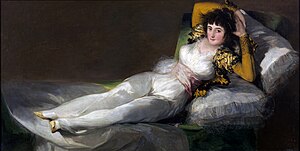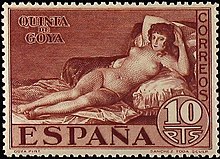The naked Maja

|
| La maja desnuda |
|---|
| Francisco de Goya , 1795-1800 |
| Oil on canvas |
| 97 × 190 cm |
| Museo del Prado |
The naked Maja (Spanish: La maja desnuda ) is an oil painting by Francisco José de Goya y Lucientes from 1795–1800 depicting a naked woman resting on a pillow. It belongs to the inventory of the Museo del Prado , Madrid .
Dressed Maja
Goya painted a second version of the picture ( La maja vestida , The Dressed Maja), on which the model is shown in the same pose but clothed.
history
The genesis of the paintings and the identity of the model are unclear. Both images appear for the first time in a document in the private cabinet of the Spanish Prime Minister Manuel de Godoy , which sparked suspicions that Maja represented one of his lovers. Maja is not a name in this context, but a Spanish term for an attractive girl or young woman from the lower class. However, it was at times fashionable in affluent circles to be painted as Maja . Another theory says that the picture is a representation of the 13th Duchess of Alba , who was painted several times by Goya and possibly also had a relationship with the painter. It is also possible that there is a mixture of different models and that no individual is shown. According to the art historian Sabine Poeschel, the young woman shows herself to be as self-confident as she is a professional prostitute , because she is depicted without “any ennoblement to Venus ”, which in other works justified erotic image motifs using classic iconography and secured the artist. For Poeschel the painting is “the first completely profane, life-size female nude in European art”.
In 1815 Goya was summoned to the Spanish Inquisition to find out who had commissioned him to paint the "obscene" pictures. The naming as Majas was done by the Inquisition. There is no record of Goya's testimony. As a result of the process, however, he was stripped of the title of royal court painter . After she was discovered in a so-called Venus cabinet of a Madrid palace (a room for the secret hanging of forbidden pictures), the naked Maja was confiscated in 1808 and initially in the magazines of the Inquisition for 85 years and then in the camp of the Real Academia de Bellas Artes de San Fernando , kept under lock and key. As a result, the painting was almost completely unknown for a long time. It was therefore not used by Édouard Manet as a model for his similarly designed painting Olympia (1863). Both Majas were presented to the public for the first time in 1900.
In 1930 Spain issued four postage stamps with Goya's most famous paintings, including the naked Maja. Spanish Catholics and other countries protested unsuccessfully against the stamp.
literature
- Ivan Nagel : The artist as a matchmaker . Goya's naked and clothed Maja. 1st edition. Hanser, Munich / Vienna 1997, ISBN 3-446-19124-0 .
- Werner Busch : Goya's "Naked and Clothed Maja" . In: Braunmühl, Claudia von [Hrsg.]: Established science and feminist theory in dialogue. 1st edition. Berliner Wissenschafts-Verlag, Berlin 2003, ISBN 978-3-8305-0346-0 .


